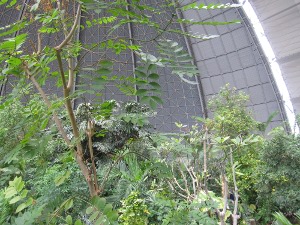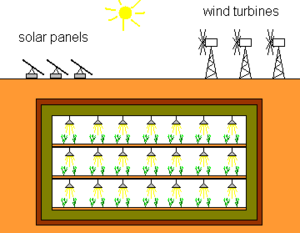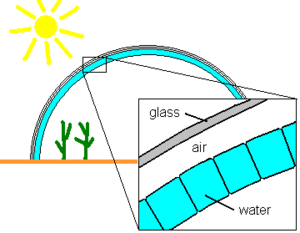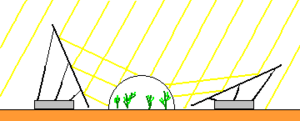Greenhouse

Greenhouses and grow rooms are types of agricultural facilities. Growing plants in a Greenhouse delivers oxygen and food. It can play an important part in human recreation (Mars Garden) and may be the place for funerals. The sunlight is not bright enough on Mars to allow most terrestrial plants to thrive, but it can provide a valuable part of the light energy required for plants. Additional energy is necessary for lighting and heating to get higher yields. Food production facilities may include biological reactors for bulk protein and carbohydrates production, sidestepping plant production altogether. Grow rooms, with entirely artificial lighting conditions, are also an alternative.
The greenhouse must be constructed from transparent material, allowing maximum sunlight to pass, generating an artificial "greenhouse effect". This effect may be enhanced by filling the greenhouse with potent greenhouse gasses such as sulfur hexafluoride. (very doubtful) The spectral properties of the transparent material should be optimized to match the absorption characteristics of chlorophyll, maximizing the energy gain, possibly using a layer of quantum dots[1] (Speculative).
Plants need a mix of air pressure and temperature. The greenhouse must be strong enough to hold that air pressure, and it must be insulated to hold the interior temperature. Photosynthesis works best at fairly high temperatures, 20°C and more.
Contents
- 1 Side-lit Greenhouse Concept
- 2 Underground Greenhouse Concept (Grow room)
- 3 Water-shield Greenhouse Concept
- 4 Multiplying Sunlight
- 5 Flora and fauna
- 6 Maintenance
- 7 Nutrition and Energy Calculations
- 8 Wind and air movement
- 9 Dust storms
- 10 Radiation damage
- 11 Open Issues
- 12 See Also
- 13 External links
Side-lit Greenhouse Concept
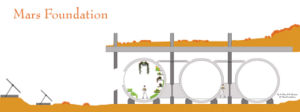
The Mars Foundation concept for a greenhouse involves the maximum use of local materials to avoid waste, maximize energy input and optimize space. Spawned from the Hillside settlement design, the greenhouse would most likely be located inside/next to a hill side (possibly in the location of Candor Chasma). Therefore regolith or some other absorbent material could be suspended above the greenhouse to protect occupants and plants from harmful radiation. The source of light would therefore be directed from the side, via an array of adjustable mirrors. A system of vents and ducts would allow warm air to circulate, perhaps even used to heat the main habitat. A significant part of sunlight on Mars is diffuse and cannot be reflected by a mirror, so the number of mirrors required must take this into account.
Underground Greenhouse Concept (Grow room)
If geothermal energy or nuclear power is not available the heating will consume large amounts of electrical energy. In this case the sum of energy used for lighting and heating must be considered. An underground greenhouse is easier to insulate to hold warmth inside. On the other hand the effort of lighting is higher, since no direct sunlight is used. This concept has some additional advantages: It is meteorite-safe and radiation-safe.
Natural caves and artificial caves can be utilized to build such an underground greenhouse, which requires a preparation with high effort in either case. The maintenance may be less that for a surface greenhouse, for the ambient temperatures are steady and the radiation levels are low. A combination of greenhouse and living space for the settlers might be possible, but high productivity greenhouses will be warm, humid, rich in CO2 and with very high lighting levels. These are not necessarily the best conditions for humans, so grow rooms will probably be build as separate environments from the general habitat.
The Mars One concept for the initial settlement was an inflatable greenhouse with a thick cover of regolith.
Artificial lighting equivalent to the average illumination level on Earth is 600 W/m2 and more. With an insulated grow room, this energy must be removed from the grow room to avoid overheating. However, the lighting is required for proper growth. Therefore a grow room will need to be cooled using mechanical cooling, as is the case on Earth. Plant also evaporate a large quantity of water by evapotranspiration for their normal growth. The water must be removed by cooling or some other method from the air, as saturated air will no longer allow evapotranspiration and the plants will not survive. Compression work required to cool the air and remove the water is usually in the order or 25 to 33% of the light load to the area. So beyond the 600W/*m2 of lighting up to another 200 W/m2 may be required to power the cooling of the grow rooms. Alternatively, water cooled in the Martian regolith or through surface radiators could be used to cool the grow rooms without the added energy of compression.
Water-shield Greenhouse Concept
Hydrogen does a good job absorbing cosmic radiation. Water contains highly concentrated hydrogen, and hence serves as a good radiation shield. On the other hand it is highly transparent for visible light and UV. The combination of both makes it an interesting material for greenhouse shielding. The spectrum of the light that gets through the water needs to be evaluated.
Under a strong pressure resistant housing the water is placed in a thick layer. It absorbs the dangerous parts of cosmic radiation and sunlight and passes most of the spectral parts needed by humans and plants. Additionally, it helps to buffer daily temperature variations because of its high specific heat capacity.
The layering could be as follows: The outer layer is a construction of steel and glass, providing enough strength for the difference in atmospheric pressure. It also serves as insulation for temperature differences. Additional sheets of glass or plastics improve the insulation effect. A self-healing puncture protection should be considered. The innermost layer is the water. It can be held by transparent canisters.
Multiplying Sunlight
A solar concentrator is a set of mirrors that can be used to bring more sunlight into the greenhouse than the base area of the greenhouse receives directly from the sun. Three times the amount of Martian sunlight should be enough to serve terrestrial plants. During good weather periods this allows growing vegetables without additional energy.
However, up to 40% or more of Martian light is diffuse light. This light cannot be focused by a mirror and therefore the surface required will be much larger.
Flora and fauna
Plants can be grown either in liquid fertilizer (hydroponics) or in soil. Many plants live in symbiosis with microbes and insects. Bees and other insects can be used to pollinate the blossoms for fruit plants. The growth of flora and fauna under the low Martian gravity bears some uncertainties. the problem that biosphere 2 had with ants are a good example of the problems that can happen in greenhouses and artificial habitats. (citation needed).
Maintenance
Greenhouses require significant amounts of work: planting, watering, in some cases replanting and moving seedlings into sufficiently wide areas. Contamination by other plants is also likely, reducing yields and adding plant control requirements. Soils require nutrients and aeration. compost requires both space and manutention of the dead plant matter and biological wastes added to it. The greenhouse structure itself will be attacked by humidify, fatigue form temperature cycles and UV damage from the sun. The typical polythene greenhouses sheets on Earth require replacement every decade or so.
The number of workers required depends on automation levels and the production levels. The higher the production levels the more controls and intervention are required. Depending on the crop, personnel may vary from 1 (or less) per hectare for grains to 10 per hectare for tomatoes, or more for very intense grow rooms.
Although plants may grow with lower pressure and higher CO2 levels, workers will have difficulties in these conditions. Due to the many manipulations required for plant production, it may be difficult to use different pressure levels than for the rest of the habitats. CO2 and humidity may be significantly higher, however.
Nutrition and Energy Calculations
Based upon the figures in the food and sunlight articles the following calculations can be carried out for an artificially lit greenhouse:
The minimum size of cropland per person is about 365 m2. The needed light energy can be assumed with 1000 kWh per m2 and year. The result is an annual amount of 365 MWh per person. In other words: An average illumination power of 42 kW per person is required.
The usage of fluorescent lamps with an efficiency factor of 30% results in a requirement of about 140 kW per person in electrical energy. The overall efficiency of food production with artificially lit greenhouses is less then 1 permille, or in other words, to produce food with a content of 1 kWh the amount of more than 1 MWh in electricity must be spent. Progress in LED lighting will increase the overall efficiency, and some LED systems already reach 60% efficiency.
In greenhouses, part of the required light is provided by direct or indirect sunlight, reducing the energy requirements
If spread out or poorly insulated against the cold ground, heating the greenhouse may require additional energy. If stacked vertically for minimum volume usage, the energy added for lighting may cause the space to require active cooling.
Wind and air movement
Most plants need air circulation over the leaves to improve their evapotranspiration. Plants, in particular genetically modified plants with large seeds or fruit, also need to be stirred using air circulation to increase the strength of their stalks. Mars with its lower gravity might allow for weaker stalks. Heat transfer in a greenhouse depends on air movement as well, as much of the heat is removed through convection, and the humid air must be moved over a cooling system to remove the humidity. Practically all greenhouses on Earth have fans for extra air circulation and these will also be required on Mars. All grow rooms on Earth are air conditioned.
Dust storms
Greenhouses are affected by dust storms. For greenhouses with reflectors and no artificial lighting a large dust storm might be catastrophic, reducing lighting bellow the survival level of the plants.
Radiation damage
Most crops are fairly resistant to radiation damage. In addition, many crops are by their very nature regularly harvested and radiation damage does not significantly accumulate. Damage to fruit trees may be more important.
Open Issues
- What temperature and air pressure do plants need?
See Also
External links
| Concepts: | Greenhouse · Settlements · Locations · General |
| Hazards: | Space Weather · Climate · General |
| Technology: | Hi-Tech · Lo-Tech · Energy · Spaceflight science · Communication · General |
| Human Considerations: | Economics · Health · Governance · Trade · Law · Social |
